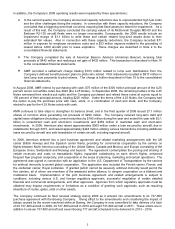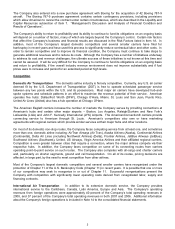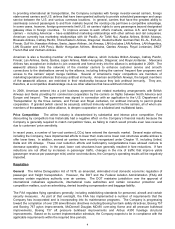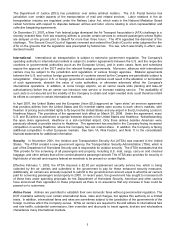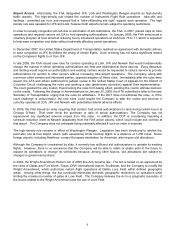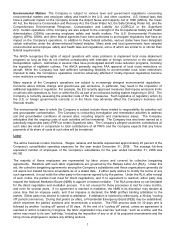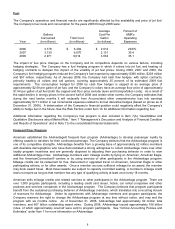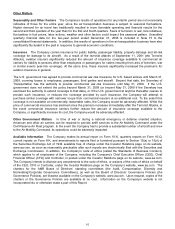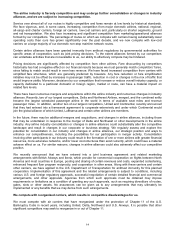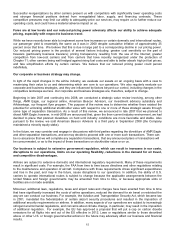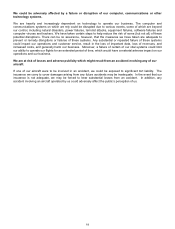American Airlines 2008 Annual Report Download - page 11
Download and view the complete annual report
Please find page 11 of the 2008 American Airlines annual report below. You can navigate through the pages in the report by either clicking on the pages listed below, or by using the keyword search tool below to find specific information within the annual report.8
In April 2003, American reached agreements (the Labor Agreements) with its three major unions - the Allied Pilots
Association (the APA) which represents American’s pilots, the Transport Workers Union of America (AFL-CIO)
(the TWU), which represents seven different employee groups, and the Association of Professional Flight
Attendants (the APFA), which represents American’s flight attendants. The Labor Agreements substantially
moderated the labor costs associated with the employees represented by the unions. In conjunction with the
Labor Agreements, American also implemented various changes in the pay plans and benefits for non-unionized
personnel, including officers and other management (the Management Reductions). The Labor Agreements
became amendable in 2008 (although the parties agreed that they could begin the negotiations process as early
as 2006). In 2006, American and the APA commenced negotiations under the RLA. In April of 2008, following a
request by the APA, a mediator was appointed by the National Mediation Board. The parties have been in
mediated negotiations since that time.
Also in 2006, American and the TWU commenced negotiations with respect only to dispatchers, one of the seven
groups at American represented by the TWU. Subsequently, following a request by the parties, a mediator was
appointed by the NMB for the dispatcher negotiations. Thereafter, in November 2007, American and the TWU
commenced negotiations under the RLA with respect to the other employee groups represented by the TWU.
Direct negotiations between American and the TWU employees with respect to those other groups continued until
December 2008, at which time the parties jointly filed with the NMB for mediation with respect to the fleet service,
stores, ground school instructors, and simulator technician groups of employees. The NMB appointed a mediator
soon thereafter. Then in January, 2009, the TWU applied to the NMB for the appointment of a mediator with
respect to the mechanics and the technical specialists. The NMB will appoint a mediator to assist those
negotiations, as well.
American and the APFA commenced negotiations in the first half of 2008. Direct negotiations between the parties
continued until December 2008, at which time the parties jointly filed an application to the NMB asking that a
mediator be appointed. The NMB appointed a mediator soon thereafter.
The Air Line Pilots Association (ALPA), which represents American Eagle pilots, reached agreement with
American Eagle effective September 1, 1997, to have all of the pilots of the American Eagle® carriers (currently
American Eagle Airlines, Inc. and Executive Airlines, Inc.) covered by a single contract. This agreement lasts until
January 1, 2013. The agreement provides to the parties the right to seek limited changes in 2000, 2004, 2008 and
2012. If the parties are unable to agree on the limited changes, the agreement provides that any issues would be
resolved by interest arbitration, without the exercise of self-help (such as a strike). ALPA and American Eagle
negotiated a tentative agreement in 2000, but that agreement failed in ratification. Thereafter, the parties
participated in interest arbitration. The interest arbitration panel determined the limited changes that should be
made and these changes were appropriately effected. In 2004 and in 2008, the parties successfully negotiated
limited changes. The pilot agreement is amendable January 1, 2013; however, the parties have agreed that
contract openers may be exchanged 120 days prior to that date.
The Association of Flight Attendants (AFA) represents the flight attendants of the American Eagle carriers. The
current agreement between the American Eagle carriers and the AFA is amendable on October 27, 2009;
however, the parties have agreed that contract openers may be exchanged 90 days prior to that date. The other
union employees at the American Eagle carriers are covered by separate agreements with the TWU. The
agreements between the American Eagle carriers and the TWU were amendable beginning on October 1, 2007,
and the parties commenced negotiations. In January, 2009, an application for mediation was filed with the NMB.
A mediator from the NMB will be assisting the parties.





